Mark Sisson's Blog, page 97
August 25, 2019
Vegetable Latkes
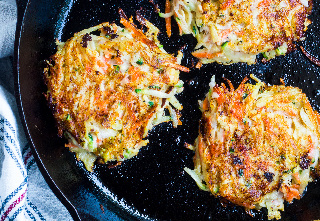 Call them what you want – latkes, vegetables pancakes, fried-deliciousness. They’re traditionally made with potatoes, a food some of us Primals feel better avoiding. The tuber’s low-moisture and high-starch content creates a crispy exterior and fluffy interior when fried in oil. The high starch content, unfortunately, is also the reason the insulin resistant among us are better off turning to less starchy vegetables to satisfy latke cravings.
Call them what you want – latkes, vegetables pancakes, fried-deliciousness. They’re traditionally made with potatoes, a food some of us Primals feel better avoiding. The tuber’s low-moisture and high-starch content creates a crispy exterior and fluffy interior when fried in oil. The high starch content, unfortunately, is also the reason the insulin resistant among us are better off turning to less starchy vegetables to satisfy latke cravings.
Although latkes made with vegetables like carrot, turnip, daikon radish and zucchini will never be quite as crispy as potato latkes, they’re darn good in their own right. The flavor of each vegetable is mild enough that you’ll still feel like you’re eating a latke, yet the latke is transformed into something new and interesting. Zucchini latkes are mildest of all, the carrot and turnip are slightly sweet, and the daikon version has just a hint of spiciness.
Notes: These latkes will work with many combinations of vegetables, especially root vegetables. To make the dish lower carb, you can swap out the sweet potato or carrot with turnips or rutabaga. Use multiple paper towels or a good hand towel to ring out moisture from the shredded vegetables, especially vegetables like daikon and zucchini. This will keep your latke batter from turning watery. To make the shredded vegetables either use the large holes on a box grater or food processor with a large grate attachment.
Servings: 3
Prep Time: 10 minutes
Cooking Time: 20 minutes
Ingredients:
1 cup shredded daikon radish
1 cup shredded zucchini
1 cup shredded carrot
1 cup shredded Japanese/white sweet potato
1.5 scoops Primal Kitchen® Collagen Peptides
2 Tbsp. almond flour
1/2 tsp. garlic powder
1/4-1/2 tsp. salt
1/4 tsp. black pepper
1 extra large egg or 2 medium eggs
¼ cup Primal Kitchen Avocado Oil
Instructions:

Preheat your oven to 400 ºFahrenheit. Place a seasoned cast iron skillet in the oven to heat.
Use a towel to squeeze out the shredded vegetables. In a large bowl, combine the shredded vegetables, collagen, almond flour, garlic powder, salt, and black pepper. Crack the egg and mix it into the vegetable mixture. Allow the mixture to rest for 1 minute.
Place the skillet over medium high heat and add 2 tablespoons of oil. Once hot, add a scoop of the vegetable mixture to the skillet and gently flatten and shape it so it’s a slightly flattened patty. Repeat 2-3 more times so the skillet has 3-4 patties. Allow the latkes to fry for 1-2 minutes on each side.

Gently use a spatula to remove the latkes and place them on a parchment-covered sheet pan. Add the remaining oil and allow it to heat before repeating the above steps with the remaining vegetable mixture.
Place the sheet pan with the latkes on it in the oven for 10-12 minutes. Allow them to cool before removing them from the pan. Enjoy on their own or with your favorite sauce. We like combining Primal Kitchen Garlic Aioli Mayo with chopped parsley and lemon, but they are also great with a sour cream or yogurt-based dip.

Nutrition Information (per serving):
Calories: 268
Total Carbs: 15 grams
Net Carbs: 12 grams
Fat: 20 grams
Protein: 10 grams
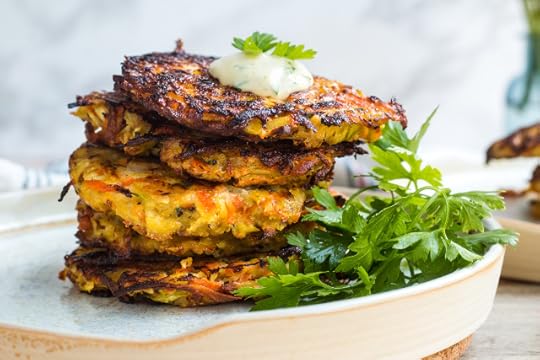

The post Vegetable Latkes appeared first on Mark's Daily Apple.



August 23, 2019
Weekly Link Love — Episode 43

Research of the Week
Endogenous opioids facilitate social closeness.
Researchers identify 14 independent biomarkers of early mortality.
Antibiotics may raise the risk of bowel cancer.
The link between air pollution and bipolar disorder.
90 days of keto helps type 2 diabetics.
New Primal Blueprint Podcasts

Episode 367: Dr. Robert Glover: Host Elle Russ welcomes Dr. Robert Glover back to the podcast.

Primal Health Coach Radio, Episode 23: Our very own Erin Power tells her tale.
Each week, select Mark’s Daily Apple blog posts are prepared as Primal Blueprint Podcasts. Need to catch up on reading, but don’t have the time? Prefer to listen to articles while on the go? Check out the new blog post podcasts below, and subscribe to the Primal Blueprint Podcast here so you never miss an episode.
Media, Schmedia
The case against using “war on cancer” metaphors.
Parents who malnourished their kid with vegan diet avoid jail time.
Interesting Blog Posts
Why African chickens have longer, meatier legs (for now).
“I heard that, up until 5 or 6 years ago, they weren’t even cooking their food…simply eating it raw right where it fell.”
Social Notes
Listen to the Sisson (and do your microworkouts).
My guess on why dogs are so fat and sick.
Everything Else
When ancient hunter-gatherers met ancient farmers, they produced some weird art.
Good article about the danger of artificial light with decent recommendations for kids who use devices. I just don’t like how they seem resigned to the trend of kids being glued to these things.
Animal Rebellion activists plan to blockade the UK’s largest wholesale meat market in October.
Things I’m Up to and Interested In
Tinfoil hats off to the people who warned about this for years: Higher maternal fluoride levels during pregnancy predict lower IQ in boys (but not girls).
Stuff gets older and older: Humans made it to Mongolia much earlier than we thought.
Very interesting idea: Did parasites select for increased human variability?
I’m not surprised: After Maryanne Demasi produced two great T.V. specials questioning the conventional wisdom on statins and heart disease, she and her entire time got fired.
When one of the most powerful vegans isn’t buying it…: Whole Foods CEO John Mackay questions the health effects of eating plant-based “meats.”
Question I’m Asking
Is the backlash to fake meat fake?
Recipe Corner
You don’t need eggs to have breakfast.
Certainly not keto, but a damn good treat: banana pancakes with sausage.
Time Capsule
One year ago (Aug 18 – Aug 24)
Tips for Cycling Between Primal and Keto – How to make both work.
My Supplement Routine: What I Take, When I Take It, and Why– How I take supplements.
Comment of the Week
“Back in the 1950s or so you could order tapeworm pills for weightloss.”
– DC, that’s the next big Primal Kitchen product: mayo with wriggling, writhing tapeworms.

The post Weekly Link Love — Episode 43 appeared first on Mark's Daily Apple.



August 22, 2019
Recovery Workouts: Two Simple But Powerful Ways to Speed Fitness Recovery
 For my entire athletic career, I considered the gold standard of recovery to be sleeping, resting on the couch watching T.V., and generally being still and inactive. Come on, what could be more effective than couch potato mode to recover from the hormonal and inflammatory stresses of marathon training runs or long days of extreme swim-bike-run workouts? I’m kidding (mostly), but it’s not a total exaggeration. Our understanding of fitness recovery has grown exponentially since I was in the elite arena, and it’s exciting to see new and better approaches taking root that genuinely speed recovery and stave off burnout. I’m sharing two such techniques today. They’re simple, mostly free, and accessible to anyone with the most basic fitness opportunities and venues.
For my entire athletic career, I considered the gold standard of recovery to be sleeping, resting on the couch watching T.V., and generally being still and inactive. Come on, what could be more effective than couch potato mode to recover from the hormonal and inflammatory stresses of marathon training runs or long days of extreme swim-bike-run workouts? I’m kidding (mostly), but it’s not a total exaggeration. Our understanding of fitness recovery has grown exponentially since I was in the elite arena, and it’s exciting to see new and better approaches taking root that genuinely speed recovery and stave off burnout. I’m sharing two such techniques today. They’re simple, mostly free, and accessible to anyone with the most basic fitness opportunities and venues.
Note: Here’s the thing…. This is the stuff you should focus on before considering advanced techniques like exposure to cold or heat, Theragun treatments (although I happen to be a fan of this device), hyperbaric oxygen chambers, etc.
“JFW”
The first recovery technique is to move more instead of just sit around. That’s right, science is validating the idea that if you make a concerted effort to increase all forms of general everyday movement in the hours and days after strenuous workouts, you will help minimize the inflammation and oxidative stress caused by strenuous workouts.
Let’s call this strategy JFW—Just F—ing Walk.
Moving your body through space helps you burn fat better, which will maximize the fat reduction goals of your workouts. Walking also helps boost brain function. A 2017 UCLA study comparing MRI scans revealed that active older folks (over 60 and walking more than three kilometers per day) have faster brain processing speed, better working memory for quick decisions, and better memory consolidation than inactive folks. In his book, The Real Happy Pill: Power Up Your Brain By Moving Your Body, Swedish researcher Dr. Anders Hansen reports that just taking a daily walk can reduce your risk of dementia by 40 percent.
Walking and general movement of any kind improve lymphatic function for a huge recovery boost. The lymphatic system is a plumbing network running throughout your body that detoxifies every cell, tissue and organ through a separate operating system from the cardiovascular system. The lymphatic system operates through a pumping process instead of a beating heart. This means that you’re obligated to move your muscles and joints to turbocharge lymphatic detoxification and avoid the pooling of lymphatic fluid caused by chilling on the couch in the hours and days after heavy workouts. Even the old-time exercise apparatus of the mini-trampoline has come into vogue recently because bouncing around for even a few minutes has been shown to significantly boost lymphatic function.
To help your lymphatic system function optimally, be sure to hydrate adequately at all times. While my original Primal Blueprint presentation suggested that you simply honor your thirst to achieve good hydration, recent science suggests that successful hydration can be a little more complicated. Stacy Sims, Ph.D., a hydration expert who studied thermoregulation at Stanford and is currently a senior research fellow at University of Waikato in New Zealand, is doing some great work in this field. Check out this fantastic infographic. Her research suggests that the female menstrual cycle can influence hydration needs and strategies. Another breakthrough insight is that strenuous workouts have the potential to mute your thirst mechanism; you may become too hot and tired or distracted to notice that you’re actually getting dehydrated. For most minimally active folks, going by thirst might be just fine; the kidneys do an excellent job regulating fluid and sodium balance in the body.
If you are a novice fitness enthusiast, a high performing athlete, or routinely exercise in hot temperatures, a deliberate pre- and post-workout hydration is a strategy worth considering and implementing. Sprinkle some high quality natural mineral salt in each glass of fluid, which will help it become better absorbed in the tissues throughout your body.
“Rebound” Workouts
Joel Jamieson, a noted trainer of world-champion MMA fighters in Washington (8WeeksOut.com—as in eight weeks out from a title bout), and developer of the Morpheus Recovery app, advocates a system called Rebound Training where specially designed workouts can actually speed recovery time in comparison with total rest. The idea that a Rebound Workout can boost recovery is validated through the tracking of Heart Rate Variability. Joel is a pioneer in Heart Rate Variability and has been tracking his fighters and other high performing athletes for decades. Yes, decades, as in dating back to the original hospital grade $30,000 units that required placement of a dozen electrodes on your skin.
The idea that a Rebound workout can beat couch time is an extraordinary revelation. Amazingly, when you drag your tired, stiff, sore body into the gym and do some foam rolling, deep breathing exercises, dynamic stretches, and even very brief explosive efforts, such as short sprints with long recovery on the bike, or “positive-only” deadlifts (lift the weight then drop it to the ground to prevent soreness caused by eccentric contractions), you can stimulate parasympathetic nervous system activity and actually accelerate recovery. The parasympathetic is known the “rest and digest” component of autonomic nervous system, and counterbalances the sympathetic “fight or flight” component.
You can learn more about Rebound Training and see a sample workout here. If you just want to dabble in the concept, know that increasing your walking and general movement in the hours and days after a challenging training session will help boost blood circulation and lymphatic function to speed recovery. I always find ways to walk more and spend more time at my stand-up desk in the 24 hours following a tough Ultimate Frisbee match or sprint workout.
Sample Restorative Workout
The next time you throw down a killer workout, trying heading to the gym the following day and creating a restorative experience.
Start by lying flat on the mat and completing 20 deep diaphragmatic breath cycles. When you’re in the prone position, you can hone good technique by placing your hand on your abdomen and making sure that the abdomen expands upon inhalation. First expand the abdomen, which enables the chest cavity to then expand outward and enable the full use of the diaphragm for a powerful breath. You notice this sequence better when laying down.
After 20 deep breaths, commence 10 minutes of foam rolling, dynamic stretches and flexibility drills.
Then, get a little sympathetic stimulation going with some bike sprints or positive only deadlifts as follows:
Exercise bike: Warmup five minutes, then sprint for 10 seconds, followed by 60 seconds of easy pedaling. Repeat for five repetitions.
Deadlift: With 70% of your one rep maximum weight, raise the bar three-quarters of the way to the top, then allow it to fall to the ground with minimal muscle engagement. Repeat five times.
The idea with these efforts is that you’ll trigger a brief stimulation of fight or flight sympathetic nervous system activity, but because the effort is so brief, you’ll prompt a compensatory parasympathetic reaction during the recovery period. The net effect of the session is to turbocharge parasympathetic for hours afterward to a greater extent than just chilling on the couch watching Netflix.
Thanks to the gentle nature of the session, you enjoy an increase in energy and alertness from getting the oxygen and blood flowing throughout the body—but without the cellular breakdown and glycogen depletion of a more strenuous workout. You should leave the gym feeling relaxed and a little looser than before the workout.
Implementing “Rebound”-style workouts, along with making a general effort to walk around more in the hours following your most challenging sessions aren’t just fun diversions; they’re part of putting recovery as the central element of your training program.
Final Thoughts…
Speaking of HRV, Jamieson offers a breakthrough insight that has helped me further appreciate the value of tracking HRV over time, and also alleviate some confusion that arose during some data accumulation over the past several years. If you’re a fan of HRV, you know a high HRV on the familiar 1-100 scale is indicative of a strong and rested cardiovascular system. You have a greater variation in beat-to-beat intervals than a lower score, indicating a harmonious balance between fight or flight sympathetic nervous system function and rest and digest parasympathetic nervous system function. A low HRV indicates a more metronomic heartbeat, and sympathetic nervous system dominance over parasympathetic. These are reliable signs of overtraining or a general overstress condition in life, or a weak cardiovascular system in general.
By tracking HRV for several weeks, you can establish a healthy baseline, then gauge your level of stress and readiness to train based on daily HRV fluctuations. Low equals overstressed, high equals healthy. That’s all well and good, but here’s an important nuance I learned from Joel about HRV readings significantly higher than your baseline: An 86 seems better than the usual 72-75, but actually an abnormally high HRV could be an indication of parasympathetic dominance versus a sympathetic-parasympathetic balance. When your parasympathetic kicks into overdrive, it’s possibly because you trashed yourself way beyond healthy limits, and you’re struggling to return to a rested and stress-balanced state. This explained some strange outlier readings where I felt pretty cooked after coming off a jet travel binge or a series of extreme workouts in a tight time frame but delivered a rock star HRV reading.
As I’ve written about before, I’m not a fan of overdoing biofeedback devices. I’ve used them and still do occasionally when I’m attempting something new or just want to check in with some hard data, but too much tech can disconnect you with your intuition—what should always be front and center in your assessments. Dr. Kelly Starrett references scientific research indicating that the single most valuable and accurate metric for your state of recovery is “desire to train.” I wonder how this goes up against the blood lactate meters at the U.S. Olympic Training Center and any ring or watch data you can accumulate. I have confidence it would hold its own in most scenarios.
Thanks for stopping by today, everybody. How do you do recovery? What have you learned over the years in your own study and experience. Have a great end to the week.

The post Recovery Workouts: Two Simple But Powerful Ways to Speed Fitness Recovery appeared first on Mark's Daily Apple.



August 21, 2019
The Definitive Guide To Fish: Why and How To Eat It
 In nutrition, there are very few universal consensuses. Conventional wisdom says that fat makes you fat and whole grains are essential, and millions of people agree, but the ancestral health and keto communities (and reality) disagree. Primal and keto folks don’t worry much about saturated fat and limit polyunsaturated fat; conventional health advocates do the opposite. The opinion on meat intake varies wildly, with some people suggesting we eat nothing but red meat, others recommending “palm-sized” pieces of strictly white meat, and still others cautioning against any meat at all. Pick a food and you can find a sizable group that hates it and a sizable one that loves it. You can find researchers who spend their lives making the case against it and researchers who spend their lives making the case for it.
In nutrition, there are very few universal consensuses. Conventional wisdom says that fat makes you fat and whole grains are essential, and millions of people agree, but the ancestral health and keto communities (and reality) disagree. Primal and keto folks don’t worry much about saturated fat and limit polyunsaturated fat; conventional health advocates do the opposite. The opinion on meat intake varies wildly, with some people suggesting we eat nothing but red meat, others recommending “palm-sized” pieces of strictly white meat, and still others cautioning against any meat at all. Pick a food and you can find a sizable group that hates it and a sizable one that loves it. You can find researchers who spend their lives making the case against it and researchers who spend their lives making the case for it.
But not fish. Fish is about as close to a universal as any food. Barring the vegans and vegetarians (some of whom, however, are sneaking wild salmon when their followers aren’t watching), everyone appreciates and extols the virtues of eating seafood. Including me.
Sea Food = Sea Change: The Evolutionary Story
Remember: I always view things through an evolutionary prism. It’s where I begin. If something doesn’t make sense in the light of evolution, it probably doesn’t make sense at all. And seafood has been one of the most important dietary factors in human brain development. Without the selenium, iodine, zinc, iron, copper, and DHA found abundantly in fish and shellfish, human brain encephalization—the massive increase in relative size and complexity of the brain representing a shift toward higher order thought—wouldn’t have been easy to pull off. Maybe impossible.
If the human brain came to rely on the nutrients found in seafood for its evolution, it stands to reason that they remain important. The studies bear this out. Fish offers unique and important benefits to humans living today.
More omega-3s in your red blood cell membranes, less heart disease.
More omega-3s in your diet, lower expression of inflammatory genes and less airway inflammation if you have asthma.
More EPA in your diet, improved depression.
More EPA and DHA in your diet, less progression from inflammation into full-blown arthritis and improved rheumatoid arthritis symptoms.
More omega-3s in your diet, stronger anabolic response to strength training.
Not to mention the imbalanced, inflammatory omega-3:omega-6 ratios most of us have, or had. Even if you’ve been Primal for ten years, you spent a good portion of your life eating the standard Western diet full of industrial seed oils high in omega-6 fatty acids. Omega-3s from seafood help correct that balance.
The Modern Picture: Calm the Alarm
But there’s a problem, isn’t there? If you listen to the alarmists, our seas are overfished and full of toxins, and the fish that remain are dripping with mercury, cadmium, and other heavy metals. Farmed fish are even worse, some say; they swim in tepid baths of antibiotics, soybean oil, and glyphosate. Besides, oceanic acidification is killing all the delicious fish and shellfish and crustaceans. Pretty soon the only thing served at Red Lobster will be fried jellyfish.
Though there are glimmers of truth to all those claims, they’re certainly exaggerated:
There are still plenty of excellent and sustainable seafood choices to make, according to Seafood Watch, which takes environmental impacts, overfishing, and other ecological and safety concerns into account.
While some species are indeed overburdened with heavy metal contamination, plenty aren’t. Eat salmon, sardines, mackerel, younger, smaller tuna. Besides, most seafood—in one study, this included shrimp, crabs, squid, and tropical fish in the Atlantic Ocean—is high enough in selenium that it binds to and prevents absorption of mercury.
Jellies may be taking over, or they may be following the natural 20-year boom and bust cycle observed throughout history.
Even farmed salmon isn’t as bad as we might assume. And farmed mollusks—oysters, clams, mussels—are as good as wild, since they live no differently from their wild cousins.
Even if all those claims were totally on the level, we’re faced with a grand overarching truth: You have to eat something. What, are you gonna eat vegan meat patties instead of cod, salmon, sardines, and oysters? Drink Soylent? Go vegan? Go Breatharian?
Of course not. You need to eat seafood. You know you should.
But isn’t it too expensive?
For one thing, I already mentioned that safe farmed fish exists. Farmed salmon probably isn’t as bad as we’ve been led to believe (or assume), as long as you watch out for the egregious ones. U.S.-farmed trout, barramundi, and catfish show up with very low toxin levels and good nutrient profiles. And farmed bivalves like oysters, clams, and mussels are raised like they’re wild. There’s basically no difference between a farmed oyster and a wild oyster. They both live out in the ocean attached to rocks, munching on what the sea provides.
Two, wild seafood isn’t always expensive.
Restaurant supply shops, Walmart, and other large stores often have frozen wild salmon, cod, and other wild fish for cheap, about $5-6 per pound.
At Costco, you can get wild caught salmon (at least on the West coast) in season for $5-6 pound. You might have to buy it whole, though (recipe down below). They also have other types of wild fish for good prices.
Canned seafood is a viable option.
Fish and Seafood: How To Optimize the Benefits
Why We Need Seafood
First, evolutionary precedent, which I already discussed. It’s folly to ignore the long history of humans eating seafood. It’s higher folly to ignore the importance of seafood in human brain evolution. Wherever they have access, people eat seafood.
Second, the benefits are well-established. Even if the links to better health are purely correlational (and they’re not, since we have controlled trials listed above), seafood looks great on paper: bioavailable protein, high levels of essential nutrients, the best source of long chained omega-3 fatty acids.
Third, seafood is a reliable source of important micronutrients that may be lacking on a terrestrial Primal, keto, or carnivore diet. Selenium, magnesium, folate, astaxanthin, and vitamin E can be tough to get if you’re just eating steaks and ground beef.
A recent study on the ketogenic Mediterranean diet had great results feeding its participants over two pounds of fish per day. Two. Pounds. Mostly salmon, sardines, and mackerel, which are fatty omega-3 rich fish very low in contaminants.
But what about those who say they’re meat eaters, turf people who claim grass-fed beef and pastured pork is enough for them? Fish is meat. Fish are animals. You’re seriously limiting your options—and selling your ancestors short—by willfully avoiding seafood. And you’re probably missing out on some important nutrients. Like iodine, for example, which doesn’t show up in the standard nutritional databases but is incredibly important for brain and thyroid health and almost certainly appears most abundantly in seafood.
What Exactly Should I Eat?
Okay, so should I just throw in some salmon and be on my way?
Salmon is a great start, but there’s way more fish (and bivalves, crustaceans, and cephalopods) in the sea.
Can’t I just take fish oil? As a fish oil purveyor, I wish I could say that fish oil is enough. It offers incredible benefits not to be dismissed, but it’s not equivalent to food either. The fact is, I do both. Seafood contains a ton more than just the omega-3s. Just check it out….
Salmon: Vitamin D3, B-vitamins, magnesium, iron, selenium.
Cod: B-vitamins, magnesium, selenium, potassium
Halibut: B-vitamins, vitamin D3, magnesium, selenium, potassium
Sardines (canned): B-vitamins, vitamin D3, selenium, calcium (if bone-in), iron, copper
Scallops: Vitamin B12, magnesium, folate, selenium, zinc.
Oysters: B-vitamins, magnesium, selenium, zinc, copper, iron, omega-3s, manganese
Mussels: B-vitamins, selenium, zinc, manganese, folate, omega-3s
Clams: Vitamin B12, iron, magnesium, vitamin A
Shrimp: B-vitamins, magnesium, selenium, zinc, astaxanthin (a potent carotenoid, great for ocular and mental health)
Crab: B-vitamins, vitamin E, magnesium, folate, selenium, zinc, copper
Lobster: B-vitamins, vitamin E, selenium
Squid: B-vitamins, magnesium, iron, copper, zinc, selenium, vitamin E
Octopus: B-vitamins, magnesium, iron, copper, zinc, selenium
Although I didn’t mention it, every single sea creature you can eat is a very good source of highly bioavailable protein and, usually, creatine.
And some studies even suggest that fish proteins themselves offer unique benefits.
In one study, rats with injured muscles saw faster recovery when fed cod protein as opposed to casein or peanut protein.
In people with insulin resistance, cod protein reduces the inflammatory marker CRP and increases insulin sensitivity.
Fish protein may even enhance fat loss and muscle gain compared to other protein sources.
Most of the research is in animals, but it’s compelling and another good—if speculative—reason to include fish in your diet.
I’m Sold. How Much Should I Eat?
Keeping in mind the contamination in certain varieties, eat much as you can afford/tolerate. It’s hard to eat too much seafood. In my experience, there seems to be a built-in regulatory mechanism that reduces the palatability of seafood at a certain level of consumption. A big slab of wild sockeye salmon is fantastic, but I can’t eat pounds of it like I can with a grass-fed ribeye.
You can also use omega-3:omega-6 ratio as an indicator. Run the numbers on the seafood you’re eating and aim for a 1:1 or 1:2 ratio and you should be golden.
In my opinion, leaner fish has no upper limit. Eat as you desire.
Keep in mind that the keto Mediterranean diet study I recently discussed gave over 2 pounds of fish to participants every day, and they had great results. Two. Pounds. Mostly salmon, sardines, and mackerel, which are fatty omega-3 rich fish very low in contaminants. After 12 weeks of that:
They lost 30+ pounds.
Their BMIs dropped from almost 37 to 31.5, from the middle of class 2 obesity to the bottom of class 1 obesity.
They lost 16 centimeters, or 6 inches, from their waist.
Fasting blood sugar dropped from 118 (pre-diabetic) to 91 (ideal).
Triglycerides dropped from 224 to 109.
HDL increased from 44 to 58.
They went from prehypertensive to normotensive.
Their liver enzymes and liver fat reduced and in some cases completely resolved.
All 22 subjects started the study with metabolic syndrome and ended it without metabolic syndrome.
As always, pay attention to how you feel. Eat and observe. Make it an official N=1 experiment and look for the feedback it provides.
How I Do Seafood
Okay, but how do you eat it? How do you prepare it?
Admittedly, there’s a lot less room for error with seafood. It goes bad more quickly, cooks faster, and simply isn’t as forgiving. We’ve all had the experience of buying some salmon fresh from the butcher, keeping it in your fridge a half day too long because we weren’t sure how to prepare it, and having to throw it out. That’s the worst.
I’m not a big “recipe” guy (I have people who help me parse out my creations into legible formats for blog posts and cookbooks). I like to improvise. A dish here, a dash there. So, I’m just going to give a freeform account of how I eat fish, shellfish, and other seafood. If you need clarification on something, feel free to ask in the comment board.
I like doing a kind of pseudo-ceviche using any high quality lean fish—halibut’s great—marinated in Primal Kitchen® Greek Dressing & Marinade with a few splashes of tamari or soy sauce and some diced fresno chile. Let it sit for 5-10 minutes, then plow into it. Really good, even though if you tried to serve this in Peru they’d probably arrest you.
I always have canned sardines from Wild Planet in my pantry. A favorite quick (and keto-friendly) meal is to do a can or two of sardines mashed up with an avocado and a tablespoon or two of Greek Goddess dressing.
If I’m doing salmon, I’ll sometimes marinate the fish in the Primal Kitchen No-Soy Teriyaki.
Another great way to cook fish is in a curry. Sear the fish, making sure to get crispy skin if it’s on. Set aside. In the same pan without washing or draining, heat up some garlic, ginger, chili peppers (if you like it hot), and onions (or shallots), adding more fat if you need it. Salt. When they’ve softened, add the curry powder or paste. Cook for a minute or so. Then add some bone broth and coconut milk. Reduce until you’ve reached the texture you desire. I’ll keep gelatin powder on hand to whisk in if it doesn’t have enough body. At the last moment, add the fish back in and toss to coat.
Scallops? Either raw at a good sushi joint, preferably separated by thinly sliced lemon, or seared in butter followed by a pan reduction with white wine and butter. By the way, for those who are interested, Butcher Box has some killer scallops now (it’s literally the last day to grab the deal—apologies to anyone reading this tomorrow.) And full disclosure—I’ve always been a proud affiliate. They do things right there.
Clam chowder is still the best way to eat clams, roasted on an open fire on the beach with a little sand still in there. Maybe it’s just the New England in me.
Anytime I’m out at a decent restaurant I trust with oysters on the menu, I order them. At least a half dozen, raw. I also like the canned smoked oysters from Crown Prince.
Mussels I like the classic way: cooked in butter, white wine, and garlic. Only modification I make is after the mussels have cooked, I remove them from the pan, sprinkle in some gelatin powder, and reduce down to make a viscous sauce.
Cod or other similar lean white fishes are best in lots of butter and garlic, followed by a squeeze of lemon.
Whole salmon? Clean, gut, and scale. If you can, keep the liver. It’s delicious. Salt and pepper the interior and exterior of the salmon. Cut some deep vertical slashes in the outside, on both sides. Stuff shallots, garlic, and lemon slices into the interior and inside the slashes. Coat with avocado oil, then grill over indirect heat with the cover on until skin is crispy and flesh is lightly pink and flaky, or bake at 375 for 30-40 minutes.
If I’m ever cooking a cephalopod, it’s all about the Instant Pot. Throw some bone broth, lemon juice, and olive oil in the pot with the squid or octopus and cook on manual for 15-20 minutes. If you like, you can take it out, allow it to cool, then grill it over coals or open flame. Save the broth.
Whenever I cook fish, I use either monounsaturated fats (as found in avocado oil and olive oil) or saturated fats (as found in butter and coconut oil). Both types of fats enhance absorption of omega-3 fatty acids, whereas omega-6 fats inhibit it. Both omega-3 and omega-6 compete for the same absorption pathway.
When applicable (as in curry), I also use turmeric to cook my fish. Turmeric and its curcumin enhances absorption of omega-3s, specifically increasing DHA levels in the brain.
I know seafood is intimidating for some people. They don’t like the “fishiness.” They don’t know how to cook it. It’s “too expensive.” It goes bad too quickly. Hopefully, after today you feel a bit better about cooking and eating seafood. Hopefully, you feel equipped and empowered to incorporate some salmon, cod, trout, oysters, and other marine animals into your diet.
Take care, everyone, and please leave your favorite ways to eat seafood down below. How much seafood do you eat? What’s your go-to recipe? What underrated sea animal do you covet but others do not?
Thanks for reading!

The post The Definitive Guide To Fish: Why and How To Eat It appeared first on Mark's Daily Apple.



August 20, 2019
Dear Mark: Olive Oil Followup
 For today’s edition of Dear Mark, I’m answering questions from last week’s olive oil post. First, is there a way to identify real olive oil and distinguish it from fraudulent olive oil? Second, should EVOO be used when grilling food? Third, how can we know if our canned seafood is packed in real, actual olive oil and not some industrial seed swill? Fourth, is algae oil worth eating? And fifth, what about just eating whole olives? Finally, why not just eat beef fat, which is also relatively high in MUFA?
For today’s edition of Dear Mark, I’m answering questions from last week’s olive oil post. First, is there a way to identify real olive oil and distinguish it from fraudulent olive oil? Second, should EVOO be used when grilling food? Third, how can we know if our canned seafood is packed in real, actual olive oil and not some industrial seed swill? Fourth, is algae oil worth eating? And fifth, what about just eating whole olives? Finally, why not just eat beef fat, which is also relatively high in MUFA?
Let’s go:
I’ve read that some “olive oil” has canola or other oils mixed in, fraudulently. Is that still an issue, and is there any way to be sure (reliable brands or sources) that what you are buying is pure and authentic?
It’s still an issue.
It all started after a raid by Italian police discovered that many olive oil producers were adding chlorophyll to sunflower and soybean oil and passing it off as EVOO. Later, UC Davis conducted a study on popular brands of imported EVOO, finding that about 70% were adulterated with seed oils. Other studies have found similar results.
Find a brand you trust. Research a maker, whether it’s a local market or a specialty brand you find at the store.
There’s this master list of olive oils certified by the North American Olive Oil Association for quality and authenticity. Many are commonly available in grocery stores.
I like it drizzled over cottage cheese for lunch or brunch, topped with cracked pepper, yum!
Finally someone agrees! This is indeed the best way to consume cottage cheese, for those who don’t know. Use at least a teaspoon of pepper, as much as you can handle.
I typically use an EVOO spray on meats before searing on the grill. Could this be harmful with the flame on high?
I wouldn’t recommend EVOO for high heat or direct flame. Personally, I use an oil made for high heat cooking in that kind of situation.
Mark,
How can one be assured that they’re packed in genuine EVOO? Is there some source/website that lists those that have been tested and verified? Call me a skeptic. If I’m Crown Prince, King Oscar, Starkist, or whoever, I’m buying massive quantities of olive oil for my fish packing operation. And the cheaper price gets my business. I’m not sending samples off to a lab to test if it’s authentic EVOO.
Good question. I can’t attest to any particular brand. It’s possible some adulterated oil could slip in, and I was unable to find any mention of it in the online literature.
If you’re concerned, drain the oil. Even if a half gram of omega-6 PUFA were to slip by, the actual fish in the can is rich enough in omega-3s that I wouldn’t worry.
For what it’s worth, I doubt something like Wild Planet sardines (what I generally buy) uses fake olive oil. Unless I’m including it specifically for a recipe, I usually pour the oil into a bowl for my dog to eat, since it’s good for her, too. (You can imagine how much she enjoys it….) Her fur shows the benefit as well.
Terrific info, thank you!
Can you do the same breakdown and analysis of algae oil? Please. I’m using ‘thrive’ brand. Thanks!
Algae oil is a good source of long chain omega-3s and has been shown to improve omega-3:omega-6 ratio in people and animals, a strong indication it “works.” Algae represents the “source” of DHA for most of the seafood we eat, in fact. Great way for vegans and vegetarians to get them.
Don’t use it for cooking. Omega-3 fats are very fragile in the presence of heat, unless protected by the
To what extent do you get the same benefits from just eating olives? I’m usually more inclined to do that… wondering if there’s any research on the health benefits?
Yep, olives are great. Love them. There isn’t really any research into olive consumption, and you’d have to get about two dozen olives to get a tablespoon worth of EVOO, but they’re bound to be good for you. Just account for the sodium intake.
Every time I see these claims about EVVO, I think:
1. EVOO is rich in MUFAs; so is BEEF FAT.
2. BEEF FAT is rich in SFAs; so is EVOO.
3. EVOO is rich in polyphenols. Does polyphenols show some improvement in healthspan and longevity in humans in a prospective study?
4. EVOO is a liquid fat. There are some studies showing that liquid fats increases intestinal permeability.
OBS.: yes, I´m doing carnivore.
1. Agreed. Beef fat is rich in MUFAs, just like EVOO.
2. Beef fat is rich in SFA, but it’s a particular type of SFA (stearic acid) that turns into MUFA in the body. EVOO isn’t really rich in SFA, though it’s rich in the MUFA that stearic acid becomes.
3. Plant phytonutrients actually do have consistent inverse associations with mortality in humans. More phytonutrients, longer lifespan. However, this isn’t measuring cause and effect. It’s very possible that people who eat more polyphenols also do other types of healthy behaviors, like exercise regularly and avoid smoking, that definitely improve longevity.
4. If anything, MUFAs (the primary fat in liquid EVOO) along with omega-3s are protective against intestinal permeability. And let’s not forget that less intestinal permeability isn’t necessarily a good thing. Increased intestinal permeability can be physiological, or it can be pathogenic.
I get the carnivore thing. I’m not against it. Beef fat is great, too. But the evidence in favor of EVOO is quite robust. Definitely robust enough for my taste.
Thanks for reading, writing, and asking, everyone. Take care and be sure to comment down below if you have any more questions!

References:
Kim Y, Je Y. Flavonoid intake and mortality from cardiovascular disease and all causes: A meta-analysis of prospective cohort studies. Clin Nutr ESPEN. 2017;20:68-77.
Cândido FG, Valente FX, Grze?kowiak ?M, Moreira APB, Rocha DMUP, Alfenas RCG. Impact of dietary fat on gut microbiota and low-grade systemic inflammation: mechanisms and clinical implications on obesity. Int J Food Sci Nutr. 2018;69(2):125-143.
The post Dear Mark: Olive Oil Followup appeared first on Mark's Daily Apple.



August 19, 2019
Primal + Keto Cooking Made Easy: Primal Oatmeal
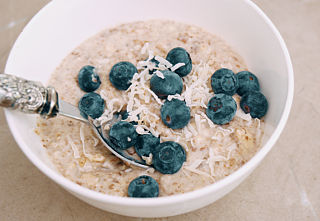 On mornings when a bowl of oatmeal is what your body craves, this hearty and comforting Primal breakfast cereal is exactly what you need. Coconut flakes, almonds, pecans, and the milk of your choice are blended into a creamy, oatmeal-like cereal and topped with fresh berries.
On mornings when a bowl of oatmeal is what your body craves, this hearty and comforting Primal breakfast cereal is exactly what you need. Coconut flakes, almonds, pecans, and the milk of your choice are blended into a creamy, oatmeal-like cereal and topped with fresh berries.
Make Primal oatmeal in the morning or the night before. Serve it hot or cold. Personalize your bowl by using different types of nuts and non-dairy milks, sweetening with pure maple syrup or yacon syrup instead of a Medjool date, and adding more flavor and nutrients with add-ins like butter, cinnamon or chia seeds. However you do it, “oatmeal” doesn’t get any tastier than this.
Serving: 1 larger serving
Time in the Kitchen: 5 minutes (plus, time to soak the nuts, if desired)
Ingredients:
¼ cup unsweetened coconut flakes (16 g)
¼ cup raw almonds, preferably soaked (1.25 oz/37 g)
¼ cup raw pecans, preferably soaked (1 oz/25 g)
½ cup coconut milk or whipping cream/full-fat milk/half and half (120 ml)
1 pitted medjool date, soaked for 20 minutes in hot water (Can omit or substitute stevia, Swerve or yacon syrup.)
1 scoop Vanilla Coconut Primal Fuel
Pinch of salt
Optional Add-ins:
Fresh berries
Butter
Cinnamon
1 tablespoon chia seeds*
Instructions:
In a high-powered blender, chop the coconut flakes and nuts until finely ground.
Add the milk, date (if desired) and a pinch of salt. Blend until thick and smooth.
Pour into serving bowls. Add more of your favorite milk, if desired, plus additional add-ins. Serve hot or cold.
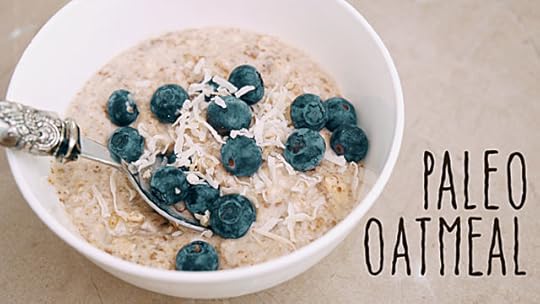
Nutritional Information (with date, without toppings):
Calories: 680
Total Carbs: 27 grams
Net Carbs: 17.3 grams
Fat: 60 grams
Protein: 19 grams

The post Primal + Keto Cooking Made Easy: Primal Oatmeal appeared first on Mark's Daily Apple.



August 18, 2019
Chocolate Collagen Pudding
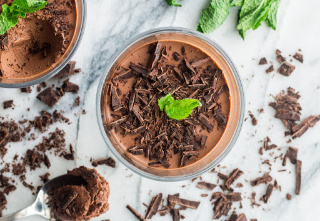
We love a good Collagen Fuel (or Primal Fuel) shake, but there’s something to be said for mixing it up. We think this Chocolate Collagen Pudding does the trick quite nicely—other non-Primal members of the household will likely think so, too. With two scoops of collagen plus cocoa powder and coconut milk (sub regular milk if you prefer), it satisfies even the most discerning chocolate lover without all the sugar and additives many puddings (especially boxed powders or premade varieties have).
And one juicy secret? You can have it two ways: mousse or pudding texture. (We think we just saw some eyes light up….) After blending the ingredients together, you can either pour the chocolate mixture into ramekins, or pour it into a pyrex container before placing in the fridge. If you do the former, you’ll get more of a mousse-like texture after the chocolate sets. If you do the latter and mix up the chocolate mixture after it sets, you’ll see more of a pudding texture. Enjoy!
Servings: 3
Prep Time: 10 minutes
Cook Time: 5 minutes
Cooling Time: 3 hours
Ingredients:

1 cup + 2 Tbsp. full-fat coconut milk
1/4 cup + 2 Tbsp. cocoa powder
2 scoops Primal Kitchen® Chocolate Coconut Collagen Fuel
1 Tbsp. maple syrup (optional, or your favorite sweetener, to taste)
1 tsp. vanilla extract
dash of salt
chopped chocolate & mint, to garnish
Directions:
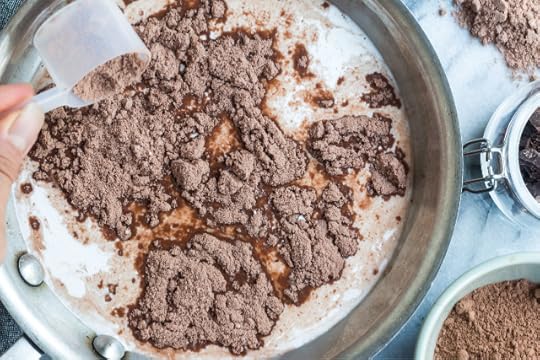
Heat ½ cup of coconut milk in a small saucepan. Once the coconut milk is warmed, sprinkle the Primal Kitchen Chocolate Coconut Collagen Fuel over the coconut milk. Remove the pan from the heat and allow the mixture to rest for 1-2 minutes. Whisk the collagen and coconut milk together. Add the vanilla extract. Sift the cocoa powder into the pan, stirring as you go.
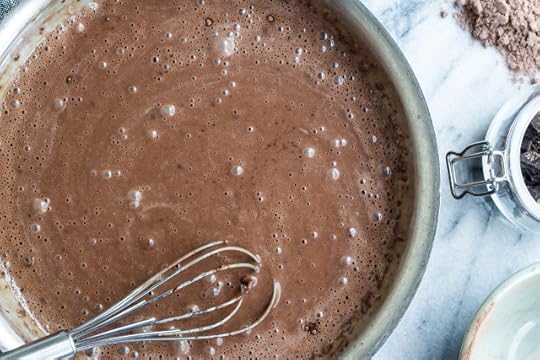
Pour mixture into a blender along with a dash of salt, the remaining coconut milk and your sweetener of choice. Blend until smooth.
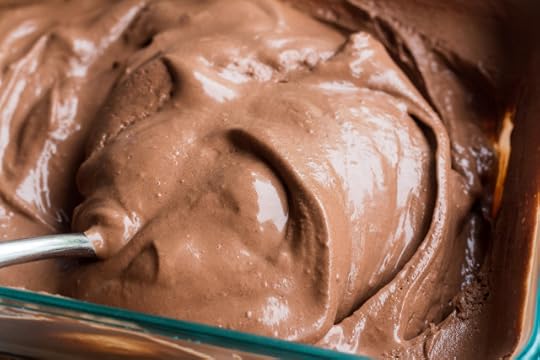
Allow the pudding to set for about 3 hours in the refrigerator. Gently mix the pudding with a spoon and pour it into ramekins or serving glasses. Garnish with chopped dark chocolate and a sprig of mint.
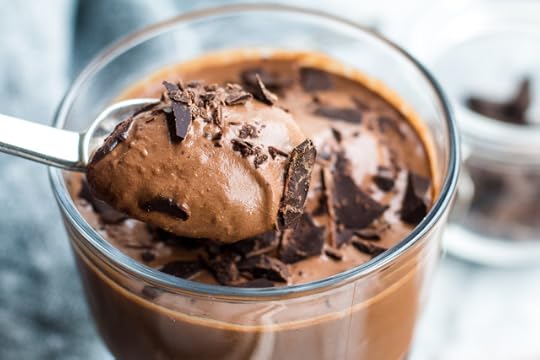
Nutrition Information (per serving):
With Maple Syrup:
Calories: 221
Total Carbs: 14 grams
Net Carbs: 5 grams
Fat: 16 grams
Protein: 10 grams
Without Maple Syrup:
Calories: 203
Total Carbs: 9 grams
Net Carbs: 5 grams
Fat: 16 grams
Protein: 10 grams
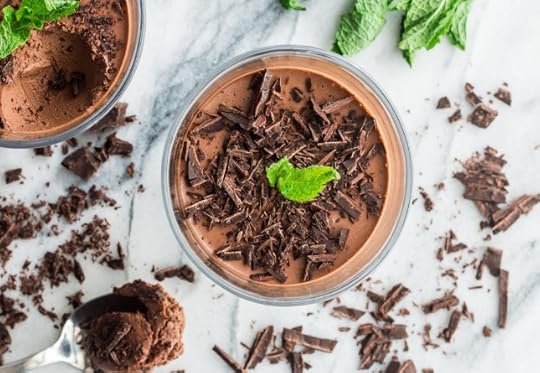

The post Chocolate Collagen Pudding appeared first on Mark's Daily Apple.



August 16, 2019
Weekly Link Love — Edition 42

Research of the Week
Findings from a new meta-analysis of vitamin D studies: D3 better than D2, D protective against cancer.
Keto is looking quite promising for cancer.
Among children with a genetic proclivity toward celiac disease, eating more gluten than average increases the risk of developing celiac.
Animal milk is better for the environment than plant milk.
Social exclusion makes the room seem darker.
New Primal Blueprint Podcasts

Episode 364: Carnivore and Cancer: Host Brad Kearns explores the relationship between carnivore dieting and cancer.

Episode 365: Paul Robinson: Host Elle Russ chats with thyroid expert Paul Robinson.

Episode 366: Keto Q&A, plus Carnivore Rationale: Host Brad Kearns fields your questions.

Primal Health Coach Radio, Episode 22: Erin and Laura welcome Brad Kearns to the podcast.
Each week, select Mark’s Daily Apple blog posts are prepared as Primal Blueprint Podcasts. Need to catch up on reading, but don’t have the time? Prefer to listen to articles while on the go? Check out the new blog post podcasts below, and subscribe to the Primal Blueprint Podcast here so you never miss an episode.
Media, Schmedia
C. diff is really enjoying the sugar in people’s diets.
NPR gives a nice rundown on the environmental benefits of grass-fed beef.
Interesting Blog Posts
Why’d it take so long to invent the bicycle?
Here’s what happens when you ignore the experts.
How meat affects the environment.
Everything Else
What’s it like being an extreme morning person?
Another famous study bites the dust.
Bronze Age marsh diets involved a lot of undercooked frogs, mollusks, and parasitic worms.
Must have been flour tortillas.
To my German readers: a meat tax may be coming.
Wanna take Neanderthal survival courses in Italy?
Humans are narrative-spinners out of necessity in a chaotic world.
Things I’m Up to and Interested In
Podcast I enjoyed doing: The Skinny Confidential, talking business, longevity, fasting, and keto.
Paper I found interesting: “Domestic Livestock and Its Alleged Role in Climate Change”
Study I found surprising: Weighted hula hooping seemingly enables spot reduction of belly fat.
I’m disappointed but not surprised: Researchers are working on a “pill for loneliness.”
I’ve been saying this for years: Why drinking tons of water isn’t the best way to hydrate.
Question I’m Asking
When has ignoring the experts worked out for you?
Recipe Corner
Chicken cracklings seriously give chicharrones a run for their money.
After serving the cracklings as an appetizer, make this BBQ burger with Hawaiian coleslaw.
Time Capsule
One year ago (Aug 11– Aug 17)
Protein Intake While Keto: Why It Matters, How Much to Eat, and What My Intake Looks Like Now – All that and more.
Wearable Weights: Are They Worth It? — Should you use them?
Comment of the Week
“I had 4 centenarians in my family in my family who lived in Greece and if they had to give blood, it would have been 90% Olive oil and 10% lunatic juice.”
– Sounds like you’ve got a marketable product there, Mike.

The post Weekly Link Love — Edition 42 appeared first on Mark's Daily Apple.



August 15, 2019
Have I Gone Full Keto?
 “Has Mark given up Primal?” I get this question all the time, and I’m not surprised. Over the past few years, I’ve really focused on exploring the utility, applications, and ins and outs of the ketogenic diet. Why?
“Has Mark given up Primal?” I get this question all the time, and I’m not surprised. Over the past few years, I’ve really focused on exploring the utility, applications, and ins and outs of the ketogenic diet. Why?
I’m still Primal and have been for over a decade. That won’t ever change. And you can go Primal—drop industrial seed oils, added sugar, and grains—and be perfectly fine. Better than 95%. You’ll lose body fat, gain energy and performance, and reduce your risk of degenerative disease. It will always be the foundation of my eating—and living. But I see (and have experienced) keto as a boost, an enhancement, a Reset. A return. Today I’m answering some questions around this idea with a new video.
Ketosis is the metabolic state in which our ancestors—all of them—spent a significant amount of time, whether from low carbohydrate availability, intense and protracted physical activity and exertion, or prolonged caloric deficits. We come from people who had to work for their food, who couldn’t count on a square well-balanced meal with “adequate” carbs, fats and protein, who sometimes simply didn’t have anything to eat for extended periods of time. As a result, they were often in ketosis. Intermittent ketosis is the metabolic milieu in which our physiologies were forged. That’s the metabolic milieu a modern person going keto is trying to emulate. It’s a smart move.
It’s why nearly everyone should spend time in ketosis. It’s why everyone should consider doing a full-on keto reset where you take six weeks to get completely fat-adapted, build up those fat-burning mitochondria, and enhance your metabolic flexibility. But, and this is a big “but,” very few people need to spend the rest of their lives there.
That’s where I am.
I’m in the Keto Zone.
Once in a while I’ll have 175 grams of carbs, usually after intense training.
Other days I might have close to zero carbs.
But most of the time I’ll hover somewhere around 50 grams of total carbs a day as defined in the Keto Reset approach.
But because I’ve built up the metabolic flexibility (and continue to refresh that flexibility with an intentional 6-week Keto Reset each year), I don’t have any issues utilizing all the various sources of energy. My energy doesn’t wane whether I eat 100 carbs or 10 carbs. Whether I’ve eaten nothing but meat or had a Big Ass Salad. I can tailor my fuel sources to my desires and requirements. That’s true flexibility. And freedom. It’s a version of Primal that works even better for me, and I’ve seen it benefit many others.
But let me share a video to take this further….
?
Thanks for stopping in, everybody. I hope I answered some questions here, but shoot me a line if there’s something outstanding or if you’re curious about something in your own Primal or Primal-keto journey. And have a great end to the week.

The post Have I Gone Full Keto? appeared first on Mark's Daily Apple.



August 14, 2019
Primal Guide to Olive Oil: Why and When to Use It
 Olive oil is the great uniter of the dietary tribes. While your Ray Peatians might grumble at the 10% PUFA content and hardcore carnivores will balk at its vegetal origins, the vast majority of dietary camps—vegans, vegetarians, paleo, Primal, keto, Mediterranean, Weight Watchers, etc.—consider olive oil to be a healthy fat. I have it on good authority that Walter Willet oils his mustache with Croatian olive oil, Dean Ornish conditions his hair with Cretan olive oil, and Peter Attia keeps a bathtub full of Damascan olive oil behind a secret panel in his library that only unlocks if you complete a tabata session on his Peloton. I even saw Shawn Baker sneaking sips from a flask with green oily fingerprints when we recently hung out. Everyone likes olive oil. There are almost no exceptions.
Olive oil is the great uniter of the dietary tribes. While your Ray Peatians might grumble at the 10% PUFA content and hardcore carnivores will balk at its vegetal origins, the vast majority of dietary camps—vegans, vegetarians, paleo, Primal, keto, Mediterranean, Weight Watchers, etc.—consider olive oil to be a healthy fat. I have it on good authority that Walter Willet oils his mustache with Croatian olive oil, Dean Ornish conditions his hair with Cretan olive oil, and Peter Attia keeps a bathtub full of Damascan olive oil behind a secret panel in his library that only unlocks if you complete a tabata session on his Peloton. I even saw Shawn Baker sneaking sips from a flask with green oily fingerprints when we recently hung out. Everyone likes olive oil. There are almost no exceptions.
This is about where I usually step in to make a contrarian claim about the super-popular food, citing some arcane study or pointing out an evolutionary argument against it.
Not with olive oil. As much as I love my avocado oil, I see no reason to question the legitimacy of extra virgin olive oil as a valid member of your diet. Personally, I include both. Here’s why….
Healthy Components of Olive Oil
Its MUFA content. Monounsaturated fats are pretty much universally lauded. Almost as resistant to oxidation as saturated fats, they raise HDL and lower LDL. Cellular membranes and mitochondria with a lot of monounsaturated fat function better than ones with more polyunsaturated fats. They’re the rock of the fatty acid world.
Its polyphenol content. Extra virgin olive oil is rich in polyphenols. Polyphenols are the plant nutrients that act as antioxidants in the plant—protecting it from predators and oxidative stress and heat and light. They act as minor toxins in us, provoking an adaptive hormetic response that makes us stronger, fitter, and healthier. Polyphenols get mixed reviews from different dietary camps. Carnivores often call them outright toxins with no benefit. Conventional skeptics usually miss the whole “hormesis” thing altogether and assume proponents think polyphenols are antioxidants that directly block oxidative stress in us. My nuanced take is that polyphenols can be pretty useful, but that there’s likely a U-shaped relationship: Too little is suboptimal, and too much is too much, just like with exercise, sun exposure, and any other type of adaptive stress we experience.
Its prominent role in classic Mediterranean cuisine. Olive oil has been eaten (and used in cosmetics, to cleanse gladiator champions, etc.) in the Mediterranean (including areas of Africa, Europe, and Asia) for thousands of years. It’s got a good track record of human use.
Those are all good theoretical reasons to use olive oil. What do human studies say?
Research Supporting Olive Oil Consumption
Overweight women ate one of two breakfasts for a year. The first was supplemented with soybean oil. The second was supplemented with extra virgin olive oil. Both breakfasts were identical save for the fat source. At the end of one year, those who ate the EVOO breakfast had higher HDL, lower inflammatory markers, better blood pressure, and lower body weight.
Type 2 diabetics with bad blood lipids either took a statin or EVOO. The statin was slightly better at reducing LDL and increasing HDL, but not by much, and the EVOO didn’t impair any physiological pathways or cause any undesired second order effects. I’d take the EVOO every time.
Among a Mediterranean population, high EVOO consumption was linked to a reduced risk of fractures and osteoporosis. High consumption of regular olive oil was not.
Extra virgin olive oil, but not corn oil, reduces postprandial oxidative stress.
Women who ate high-polyphenol EVOO every day for 8 weeks enjoyed reduced oxidative damage to their DNA.
Dietary EVOO reduced the number of oxidized LDL and increased HDL in proportion to the phenolic content of the oil; the more phenolics, the greater the effect. Tested LDL was also more resistant to oxidation after being removed from subjects and exposed to oxidative stress. Similar effects were found in a more recent study, in which men were given either EVOO with high phenolic content or refined olive oil with zero phenolics present. Men consuming high phenolic EVOO had less oxidized LDL and more phenolics present in LDL, indicating that olive phenolics reach serum LDL and exert antioxidant effects in real live actual humans.
Tips For Incorporating Olive Oil
There aren’t many foods you can’t make better by topping off with a little olive oil. The flavor of a good olive oil is nuanced enough to elevate the simplest dishes, and that’s what I enjoy about it.Think everything from marinated nuts and olives to a light dinner of Cacio e Pepe zoodles.
Cream of garlic (or cream of anything) soup? Better with a drizzle of olive oil before serving. Savory Labneh yogurt? Also better “finished” with olive oil. And don’t forget olive oil sauces. I just shared one of my favorites this week: pesto. It’s a totally modular sauce you can make with your favorite oil, nuts and herbs, but extra virgin olive oil remains the traditional choice.
And salads? Like extra virgin avocado oil, extra virgin olive oil is good with anything you throw together, this Turkish Salad being one great example. Sardine Nicoise Salad is another. Speaking of canned fish, choosing those packed in genuine extra virgin olive oil can be a flavorful option. No need to discard the oil here, especially if you incorporate the oil into the dish itself like this Olive Oil Packed Tuna and Seared Tomatoes recipe does.
Okay, so drizzling extra virgin olive oil across your dinner salad is healthy, but isn’t olive oil sensitive to heat? Aren’t you supposed to avoid cooking with it? Actually, no. Extra virgin olive oil is resistant to low and medium heat.
Despite being heated at 180 ºC (356 ºF) for 36 hours, two varieties of extra virgin olive oil exhibited strong resistance to oxidative damage and retained most of their “minor [phenolic] compounds.” Another study added olive phenols to vegetable oil, then heated it. Adding the olive phenols made the vegetable oil more resistant to oxidation and preserved the vitamin E content, offering more protection than even a synthetic antioxidant designed to do the job.
It’s not just that nothing bad really happens when you cook with EVOO. It’s also that uniquely good things happen when you cook with it.
When you cook sofrito, that Spanish staple of sauteed onions, garlic, peppers, and tomato that forms the basis of many recipes, with olive oil, it gets healthier. Cooking sofrito using olive oil has been shown to protect and enhance the polyphenols found in the various vegetables increase the bioavailability of the polyphenols. The same thing happens to other vegetables cooked in olive oil. Tomato lycopene content, too, is enhanced after cooking with olive oil.
Now, how do I use olive oil?
How I Use Olive Oil
I’ll occasionally take a teaspoon straight up, if it’s good stuff (and I only have good stuff). I really relish that peppery bite you get in the back of your throat—that’s the polyphenol burn.
I drizzle it on cooked lamb—often marinated in nothing but the same olive oil—and follow with flaky salt. Lamb stands up well to more complex marinades, but it’s also great grilled plain and drizzled with good EVOO and salt. Nothing else.
Tomato and cucumber salad. Tomato, cucumber, EVOO, balsamic vinegar, salt. Nothing fancy.
If you haven’t noticed, I like to use good EVOO where I can taste it.
I love preparing fish with olive oil. There’s even evidence that olive oil and fish fat have a synergistic effect on blood lipids and oxidative stress, combining to exert greater benefits than either fat alone or through simple addition.
To sum up…
Olive oil is great for eating cold and dressing salads. This really brings out the flavors and preserves the polyphenols.
But olive oil is great for many cooking methods, too. Olive oil is resistant to heat damage in low and medium heat applications like slow roasting, baking and light sauteing, thanks to the stability of the fatty acids and antioxidant capacity of the polyphenols. It preserves and even enhances nutrient content of vegetables when used to cook.
Olive oil has been around for millennia, and it will continue to stick around. I happen to love Mediterranean food, so you’ll always find it in my kitchen.
In fact, when researchers tried to justify replacing EVOO with canola oil as the primary fat in the Mediterranean diet, they couldn’t do it. Wanted to, but couldn’t. Can you imagine? You’re on your honeymoon, traveling through Tuscany. You stop at a rustic vineyard. The proprietor, Giancarlo, wants to show you his prized homegrown oil, just pressed. He brings in a cask of the finest canola oil; you can still smell the hexane residues.
No thanks.
Thanks for reading, everyone. Do you like olive oil? How do you use it? What’s your favorite way to consume it?
Take care.

References:
Galvão cândido F, Xavier valente F, Da silva LE, Gonçalves leão coelho O, Gouveia peluzio MDC, Gonçalves alfenas RC. Consumption of extra virgin olive oil improves body composition and blood pressure in women with excess body fat: a randomized, double-blinded, placebo-controlled clinical trial. Eur J Nutr. 2018;57(7):2445-2455.
Khan TM, Iqbal S, Rashid MA. Comparison Of Lipid Lowering Effect Of Extra Virgin Olive Oil And Atorvastatin In Dyslipidaemia In Type 2 Diabetes Mellitus. J Ayub Med Coll Abbottabad. 2017;29(1):83-86.
García-gavilán JF, Bulló M, Canudas S, et al. Extra virgin olive oil consumption reduces the risk of osteoporotic fractures in the PREDIMED trial. Clin Nutr. 2018;37(1):329-335.
Carnevale R, Pignatelli P, Nocella C, et al. Extra virgin olive oil blunt post-prandial oxidative stress via NOX2 down-regulation. Atherosclerosis. 2014;235(2):649-58.
Salvini S, Sera F, Caruso D, et al. Daily consumption of a high-phenol extra-virgin olive oil reduces oxidative DNA damage in postmenopausal women. Br J Nutr. 2006;95(4):742-51.
Marrugat J, Covas MI, Fitó M, et al. Effects of differing phenolic content in dietary olive oils on lipids and LDL oxidation–a randomized controlled trial. Eur J Nutr. 2004;43(3):140-7.
De la torre-carbot K, Chávez-servín JL, Jaúregui O, et al. Elevated circulating LDL phenol levels in men who consumed virgin rather than refined olive oil are associated with less oxidation of plasma LDL. J Nutr. 2010;140(3):501-8.
Allouche Y, Jiménez A, Gaforio JJ, Uceda M, Beltrán G. How heating affects extra virgin olive oil quality indexes and chemical composition. J Agric Food Chem. 2007;55(23):9646-54.
Casal S, Malheiro R, Sendas A, Oliveira BP, Pereira JA. Olive oil stability under deep-frying conditions. Food Chem Toxicol. 2010;48(10):2972-9.
Fullana A, Carbonell-barrachina AA, Sidhu S. Comparison of volatile aldehydes present in the cooking fumes of extra virgin olive, olive, and canola oils. J Agric Food Chem. 2004;52(16):5207-14.
Esposto S, Taticchi A, Di maio I, et al. Effect of an olive phenolic extract on the quality of vegetable oils during frying. Food Chem. 2015;176:184-92.
Rinaldi de alvarenga JF, Quifer-rada P, Westrin V, Hurtado-barroso S, Torrado-prat X, Lamuela-raventós RM. Mediterranean Sofrito Home-Cooking Technique Enhances Polyphenol Content In Tomato Sauce. J Sci Food Agric. 2019;
Rinaldi de alvarenga JF, Quifer-rada P, Francetto juliano F, et al. Using Extra Virgin Olive Oil to Cook Vegetables Enhances Polyphenol and Carotenoid Extractability: A Study Applying the Technique. Molecules. 2019;24(8)
Ramírez-anaya Jdel P, Samaniego-sánchez C, Castañeda-saucedo MC, Villalón-mir M, De la serrana HL. Phenols and the antioxidant capacity of Mediterranean vegetables prepared with extra virgin olive oil using different domestic cooking techniques. Food Chem. 2015;188:430-8.
Vallverdú-queralt A, Regueiro J, De alvarenga JF, Torrado X, Lamuela-raventos RM. Carotenoid profile of tomato sauces: effect of cooking time and content of extra virgin olive oil. Int J Mol Sci. 2015;16(5):9588-99.
Hoffman R, Gerber M. Can rapeseed oil replace olive oil as part of a Mediterranean-style diet?. Br J Nutr. 2014;112(11):1882-95.
The post Primal Guide to Olive Oil: Why and When to Use It appeared first on Mark's Daily Apple.



Mark Sisson's Blog
- Mark Sisson's profile
- 199 followers



